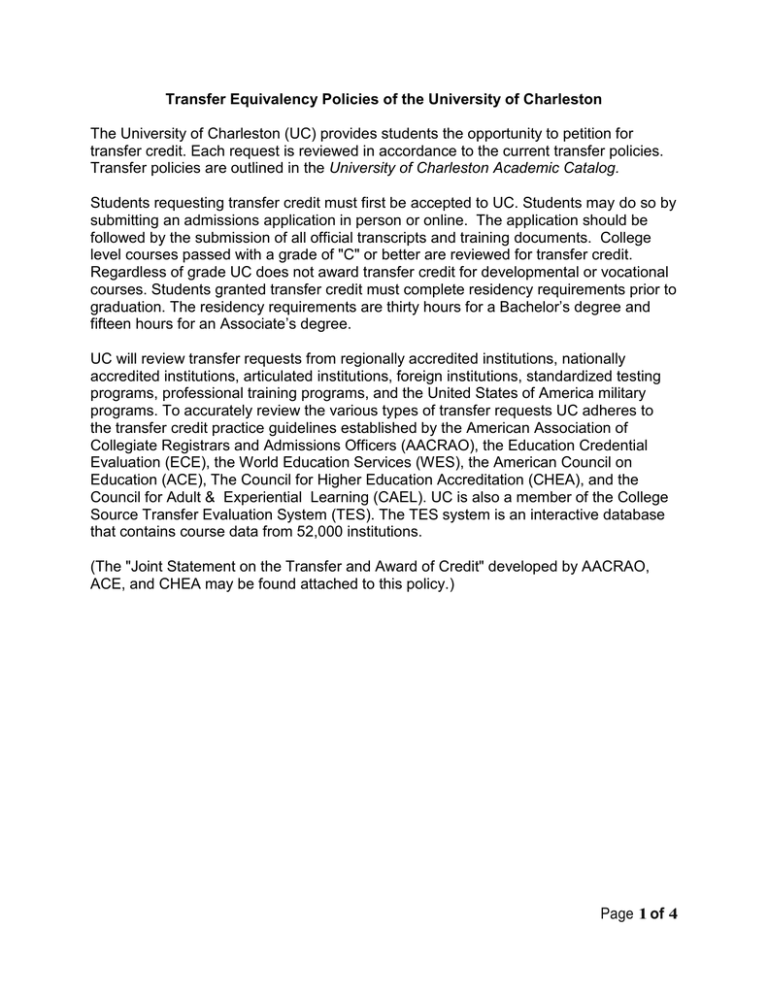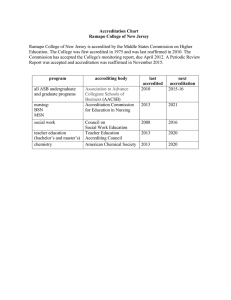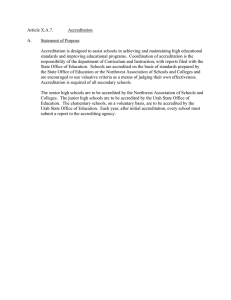UC`s transfer equivalency policies.
advertisement

Transfer Equivalency Policies of the University of Charleston The University of Charleston (UC) provides students the opportunity to petition for transfer credit. Each request is reviewed in accordance to the current transfer policies. Transfer policies are outlined in the University of Charleston Academic Catalog. Students requesting transfer credit must first be accepted to UC. Students may do so by submitting an admissions application in person or online. The application should be followed by the submission of all official transcripts and training documents. College level courses passed with a grade of "C" or better are reviewed for transfer credit. Regardless of grade UC does not award transfer credit for developmental or vocational courses. Students granted transfer credit must complete residency requirements prior to graduation. The residency requirements are thirty hours for a Bachelor’s degree and fifteen hours for an Associate’s degree. UC will review transfer requests from regionally accredited institutions, nationally accredited institutions, articulated institutions, foreign institutions, standardized testing programs, professional training programs, and the United States of America military programs. To accurately review the various types of transfer requests UC adheres to the transfer credit practice guidelines established by the American Association of Collegiate Registrars and Admissions Officers (AACRAO), the Education Credential Evaluation (ECE), the World Education Services (WES), the American Council on Education (ACE), The Council for Higher Education Accreditation (CHEA), and the Council for Adult & Experiential Learning (CAEL). UC is also a member of the College Source Transfer Evaluation System (TES). The TES system is an interactive database that contains course data from 52,000 institutions. (The "Joint Statement on the Transfer and Award of Credit" developed by AACRAO, ACE, and CHEA may be found attached to this policy.) Page 1 of 4 The following paragraphs provide specific information regarding UC's utilization of the previously mentioned guidelines in order to determine transferability. Regionally Accredited Institutions UC reviews regionally accredited institutions based upon the AACRAO transfer credit practice guidelines. The process requires the evaluation staff to first verify accreditation status, credit type, and credit practice. If approved the evaluation staff then reviews course descriptions and consults with faculty content specialists to determine the appropriate transfer equivalency. The evaluation staff enters the approved credit on the student's UC academic record. Once the evaluation is complete the student is notified by the evaluation staff, the Admission’s Office, or Student Solutions Center of the evaluation via the student's UC email. The email also includes contact information for the evaluation staff and contact information for the student's academic advisor. Developmental level, vocational level, and grades less than a "C" are the only factors that would cause a student's transfer request from a regionally accredited institution to be denied Nationally Accredited Institutions UC reviews nationally accredited institutions based upon the AACRAO, ACE, or NCCRS transfer credit practice guidelines . The process requires the evaluation staff to first verify accreditation status, credit type, and credit practice. If approved, the evaluation staff then reviews course descriptions and consult with faculty content specialists to determine the appropriate transfer equivalency. The evaluation staff enters the approved credit on the student's UC academic record. Once the evaluation is complete the student is notified by the evaluation staff, the Admission Office, or Student Solutions Center of the evaluation via the student's UC email. The email also includes contact information for the evaluation staff and contact information for the student's academic advisor. Several factors will cause a student's transfer request to be denied from a nationally accredited institution . The most common are credit type, credit practice, developmental level, vocational level, and a grade of less than a "C". Articulated Institutions UC reviews articulated institutions based upon the transfer credit protocols established in the articulation agreement. The process requires the evaluation staff to verify that the credit meets the terms of the current agreement. If approved Page 2 of 4 the evaluation staff enters the credit on the student's UC academic record. Once the evaluation is complete the student is notified by the evaluation staff, the Office of Admissions, or Student Solutions Center of the evaluation via the student's UC email. The email also includes contact information for the evaluation staff and contact information for the student's academic advisor. Dates of attendance, courses not approved on the current articulation agreement, and grades less than a "C" are the only factors that would cause a student's transfer request from an articulated institution to be denied. Foreign Institutions UC reviews foreign institutions based upon the ECE and WES transfer credit guidelines . The process requires the evaluation staff to verify credit recommendations provided by ECE or WES. UC also participates in AACRAO' s Electronic Database for Global Education (EDGE), a web-based resource for the evaluation of foreign educational credentials. The evaluation staff must then review course descriptions and consult with faculty content specialists to determine the appropriate transfer equivalency. The evaluation staff enters the approved credit on the student's UC academic record. Once the evaluation is complete the student is notified by the evaluation staff, the Admissions Office, or Student Solutions Center of the evaluation via the student's UC email. The email also includes contact information for the evaluation staff and contact information for the student's academic advisor. Developmental level, vocational level, and grades less than a "C" are the only factors that would cause a student's transfer request from a WES or ECE reviewed institution to be denied. Standardized Testing Programs UC reviews College Level Examination Program (CLEP), DANTES Exams (DSST), Advanced Placement Exams (AP), Dual Credit, and the West Virginia Department of Education Earn a Degree, Graduate Early (EDGE) Program. The process requires the evaluation staff to verify the exam score and current credit recommendation. If approved the evaluation staff enters the credit on the student's UC academic record. Once the evaluation is complete the student is notified by the evaluation staff, the Office of Admissions, or Student Solutions Center of the evaluation via the student's UC email. The email also includes contact information for the evaluation staff and contact information for the student's academic advisor. A failing exam score is the only factor that would cause a student's transfer request from an approved exam to be denied. Page 3 of 4 United States Military Credit UC reviews military institutions based upon ACE transfer credit guidelines. Academic course work from a Joint Services Transcript (JST) or Community College of the Air Force (CCAF) transcript are acceptable for review. The process requires the evaluation staff to verify credit recommendations provided by ACE. The evaluation staff must then review the military occupation specialties (MOS) descriptions and consult with faculty content specialists to determine the appropriate transfer equivalency. The evaluation staff enters the approved credit on the student's UC academic record. Once the evaluation is complete the student is notified by the evaluation staff, the Admission Office, or Student Solutions Center of the evaluation via the student's UC email. The email also includes contact information for the evaluation staff and contact information for the student's academic advisor. Vocational level MOS is the only factor that would cause a student's transfer request from a military institution to be denied. Training Organizations UC reviews training organizations based upon ACE, NCCRS, and CAEL transfer credit guidelines. The process requires the evaluation staff to verify the accrediting or licensing agency for the requested program or academy. If approved the evaluation staff then reviews curriculum information, contact hours, and dates of attendance. Once the initial review is complete the Director of Educational Partnerships makes a credit recommendation to the UC Articulation\Memorandum of Understanding Committee for final approval. Once the evaluation is complete the student is notified by the evaluation staff, the Office of Admissions, or Student Solutions Center of the evaluation via the student's UC email. The email also includes contact information for the evaluation staff and contact information for the student's academic advisor. Several factors will cause a student's transfer request to be denied from a training organization. The most common are lack of an accrediting or licensing agency, lack of curriculum information, lack of mechanism to determine the amount of knowledge the student retained from the training, too few contact hours to convert into semester credit, developmental level learning, and vocational level learning. Page 4 of 4 AACRAO's Transfer Credit Practices (TCP) Online http://tcp.aacrao.orglmi sc/j oint_statement.pl Joint Statement on the Transfer and Award of Credit The following set of guidelines has been developed by the three national associations whose member institutions are directly involved in the transfer and award of academic credit: the American Association of Collegiate Registrars and Admissions Officers, the American Council on Education, and the Council for Higher Education Accreditation. The need for such a statement came from an awareness of the growing complexity of transfer policies and practices, which have been brought about, in part, by the changing nature of postsecondary education. With increasing frequency, students are pursuing their education in a variety of institutional and extra institutional settings. Social equity and the intelligent use of resources require that validated learning be recognized wherever it takes place. The statement is thus intended to serve as a guide for institutions developing or reviewing policies dealing with transfer, acceptance and award of credit. 'Transfer" as used here refers to the movement of students from one college, university or other education provider to another and to the process by which credits representing educational experiences, courses, degrees or credentials that are awarded by an education provider are accepted or not accepted by a receiving institution. Basic Assumptions This statement is directed to Institutions of postsecondary education and others concerned with the transfer of academic credit among Institutions and the award of academic credit for learning that takes place at another Institution or education provider. Basic to this statement Is the principle that each Institution is responsible for determining its own policies and practices with regard to the transfer, acceptance, and award of credit. Institutions are encouraged to review their policies and practices periodically to assure that they accomplish the Institutions' objectives and that they function in a manner that is fair and equitable to students. General statements of policy such as this one or others referred to, should be used as guides, not as substitutes, for institutional policies and practices. Transfer and award of credit is a concept that Increasingly Involves transfer between dissimilar Institutions and curricula and recognition of extra- institutional learning, as well as transfer between institutions and curricula with similar characteristics . As their personal circumstances and educational objectives change, students seek to have their learning, wherever and however attained, recognized by Institutions where they enroll for further study. It Is Important for reasons of social equity and educational effective ness for all Institutions to develop reasonable and definitive policies and procedures for acceptance of such learning experiences, as well as for the transfer of credits earned at another institution. Such policies and procedures should provide maximum consideration for the individual student who has changed institutions or objectives. It Is the receiving institution's responsibility to provide reasonable and definitive policies and procedures for determining a student's knowledge in required subject areas. All sending Institutions have a responsibility to furnish transcripts and other documents necessary for a receiving Institution to judge the quality and quantity of the student's work. Institutions also have a responsibility to advise the student that the work reflected on the transcript may or may not be accepted by a receiving institution as bearing the same (or any) credits as those awarded by the provider Institution, or that the credits awarded will be applicable to the academic credential the student is pursuing. Inter-Institutional Transfer of Credit Transfer of credit from one Institution to another Involves at least three considerations: (1)the educational quality of the learning experience which the student transfers; (2)the comparability of the nature, content, and level of the learning experience to that offered by the receiving Institution; and (3)the appropriateness and applicability of the learning experience to the programs offered by the receiving institution, in light of the student's educational goals. Accredited Institutions Accreditation speaks primarily to the first of these considerations, serving as the basic indicator that an institution meets certain minimum standards. Users of accreditation are urged to give careful attention to the accreditation conferred by accrediting bodies recognized by the Council for Higher Education Accreditation (CHEA) . CHEA has a formal process of recognition which requires that all accrediting bodies so recognized must meet the same standards. Under these standards, CHEA has recognized a number of accrediting bodies, Including: (1)regional accrediting commissions (which historically accredited the more traditional colleges and universities but which now accredit proprietary, vocational-technical, distance learning providers, and single-purpose Institutions as well); (2)national accrediting bodies that accredit various kinds of specialized Institutions, Including distance learning providers and freestanding professional schools; and (3)professional organizations that accredit programs within multipurpose institutions. Although accrediting agencies vary In the ways they are organized and In their statements of scope and mission, all accrediting bodies that meet CHEA's standards for recognition function to ensure that the Institutions or programs they accredit have met generally accepted minimum standards for accreditation. Accreditation thus affords reason for confidence in an institution's or a program's purposes, in the appropriateness of its resources and plans for carrying out these purposes, and in its effectiveness in accomplishing its goals, insofar as these things can be judged. Accreditation speaks to the probability, but does not guarantee, that students have met acceptable standards of educational accomplishment I of 3 10/14/2014 9:00 , AACRAO's Transfer Credit Practices (TCP) Online http://tcp.aacrao.org/rnisc/j oint_statement.php Comparability and Applicability Comparability of the nature, content, and level of transfer credit and the appropriateness and applicability of the credit earned to programs offered by the receiving Institution are as important In the evaluation process as the accreditation status of the institution at which the transfer credit was awarded. Since accreditation does not address these questions, this Information must be obtained from catalogues and other materials and from direct contact between knowledgeable and experienced faculty and staff at both the receiving and sending institutions .When such considerations as comparability and appropriateness of credit are satisfied, however, the receiving Institution should have reasonable confidence that students from accredited Institutions are qualified to undertake the receiving Institution's educational program. n its articulation and transfer policies, the Institution should judge courses, programs and other learning experiences on their learning outcomes, and the existence of valid evaluation measures, Including third-party expert review, and not on modes of delivery . Admissions and Degree Purposes At some Institutions there may be differences between the acceptance of credit for admission purposes and the applicability of credit for degree purposes. A receiving institution may accept previous work, place a credit value on It, and enter it on the transcript. However, that previous work, because of its nature and not its inherent quality, may be determined to have no applicability to a specific degree to be pursued by the student. Institutions have a responsibility to make this distinction, and its implications, clear to students before they decide to enroll. This should be a matter of full disclosure, with the best Interests of the student In mind. Institutions also should make every reasonable effort to reduce the gap between credits accepted and credits applied toward an educational credential. Additional Criteria for Transfer Decisions The following additional criteria are offered to assist Institutions, accreditors and higher education associations In future transfer decisions. These criteria are intended to sustain academic quality in an environment of more varied transfer, assure consistency of transfer practice, and encourage appropriate accountability about transfer policy and practice. Balance in the Use of Accreditation Status in Transfer Decisions. Institutions and accreditors need to assure that transfer decisions are not made solely on the source of accreditation of a sending program or Institution. While acknowledging that accreditation is an important factor, receiving institutions ought to make clear their institutional reasons for accepting or not accepting credits that students seek to transfer. Students should have reasonable explanations about how work offered for credit is or Is not of sufficient quality when compared with the receiving Institution and how work is or is not comparable with curricula and standards to meet degree requirements of the receiving Institution. Consistency. Institutions and accreditors need to reaffirm that the considerations that inform transfer decisions are applied consistently In the context of changing student attendance patterns (students likely to engage in more transfer) and emerging new providers of higher education (new sources of credits and experience to be evaluated). New providers and new attendance patterns increase the number and type of transfer Issues that Institutions will address- making consistency even more Important in the future. Accountability for Effective Public Communication. Institutions and accreditors need to assure that students and the public are fully and accurately informed about their respective transfer policies and practices. The public has a significant Interest In higher education's effective management of transfer, especially In an environment of expanding access and mobility . Public funding is routinely provided to colleges and universities. This funding Is accompanied by public expectations that the transfer process Is built on a strong commitment to fairness and efficiency . Commitment to Address Innovation. Institutions and accreditors need to be flexible and open In considering alternative approaches to managing transfer when these approaches will benefit students. Distance learning and other applications of technology generate alternative approaches to many functions of colleges and universities . Transfer is inevitably among these. Foreign Institutions In most cases, foreign institutions are chartered and authorized to grant degrees by their national governments, usually through a Ministry of Education or similar appropriate ministerial body. No other nation has a system comparable with voluntary accreditation as It exists In the United States. At an operational level, AACRAO's Office of International Education Services can assist Institutions by providing general or specific guidelines on admission and placement of foreign students, or by providing evaluations of foreign educational credentials. 2 of 3 I 0/14/2014 9:00 AJ AACRAO's Transfer Credit Practices (TCP) Online http ://tcp.aacrao.orwmisc/joint_statement.ph Evaluation of Extra-Institutional and Experiential Learning for Purposes of Transfer and Award of Credit Transfer and award of credit policies should encompass educational accomplishment attained in extra-institutional settings. In deciding on the award of credit for extra-institutional learning, Institutions will find the services of the American Council on Education's Center for Adult Learning and Educational Credentials helpful. One of the Center's functions is to operate and foster programs to determine credit equivalencies for various modes of extra institutional learning. The Center maintains evaluation programs for formal courses offered by the military and civilian organizations such as business, corporations, government agencies, training providers, institutes, and labor unions. Evaluation services are also available for examination programs, for occupations with validated job proficiency evaluation systems, and for correspondence courses offered by schools accredited by the Distance Education and Training Council. The results are published In a Guide series. Another resource is the General Educational Development (GED) Testing Program, which provides a means for assessing high school equivalency. For learning that has not been evaluated through the ACE evaluation processes, institutions are encouraged to explore the Council for Adult and Experiential Learning (CAEL} procedures and processes. Uses of This Statement Institutions are encouraged to use this statement as a basis for discussions in developing or reviewing institutional policies with regards to the transfer and award of credit. If the statement reflects an institution's policies, that Institution may wish to use these guidelines to inform faculty, staff, and students . It Is also recommended that accrediting bodies reflect the essential precepts of this statement In their criteria. American Association of Collegiate Registrars and Admissions Officers [signed] American Council on Education [signed] 9/28/01 (date) 9/28/01 (date) Council for Higher Education Accreditation 3 of3 [signed] 9/28/01 (date) 10/14/20 14 9:00 N


